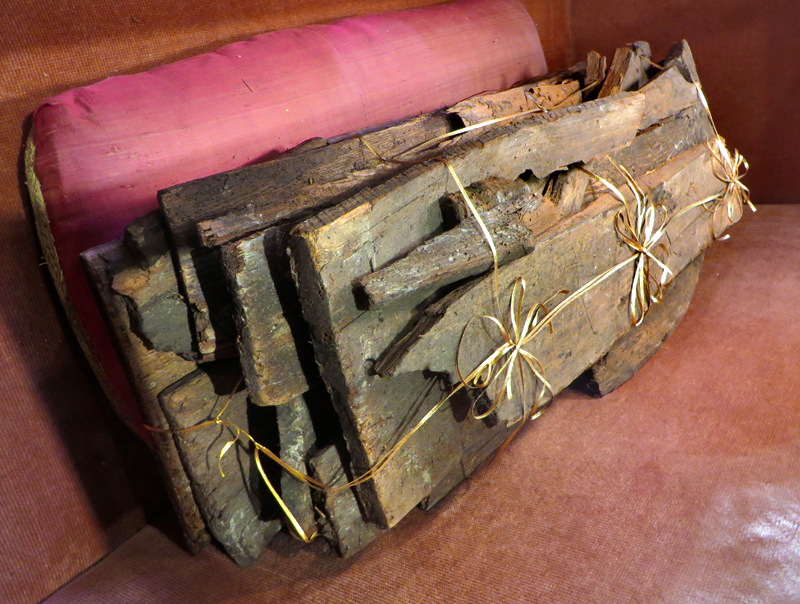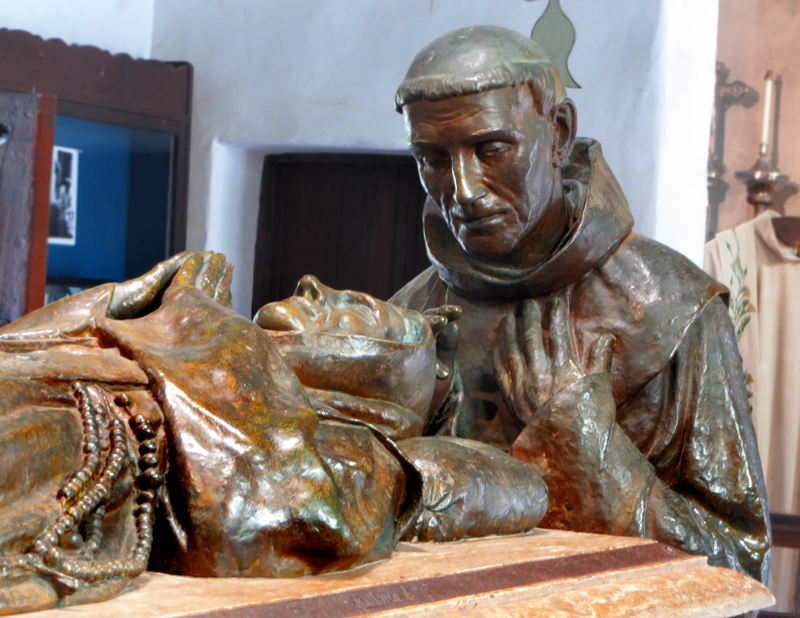|
|
Carmel Mission Basilica
|
Photos May 24, 2014
Relics of the Coffin of Blessed Fray Juniperó Serra Signage in the Basilica of Mission San Carlos Borromeo del Rio Carmelo (Carmel Mission) Father Juniperó Serra, founder of the missions of California, died here at Carmel Mission in his room on the afternoon of Aug. 28, 1784. A ship's carpenter from a vessel docked in Monterey Harbor at the time fashioned a simple casket of redwood boards to hold his body for internment [sic, s/b interment] beneath the floor of this church in the center vault on the left side of the sanctuary. The location of the grave became lost during the period the church was in ruins and was finally rediscovered after a search in the early 1880s. The location of the grave vault became obscured when the stone ceiling vault collapsed in the winter of 1851, covering it with tons of rubble. In 1943 for the process of canonization of Serra, a formal canonical tribunal composed of historians, forensic anthropologists, theologians and scholars was convened to open the grave vaults in the sanctuary of the church and conclusively identify the remains of the occupants of the vaults. After Father Serra's remains were examined and identified, they were placed in a modern metal casket before being reinterred in the grave. The pieces of the original casket, which had fallen into decay, were set aside for safekeeping and are now exhibited here in this reliquary.
About the Basilica of Mission San Carlos Borromeo del Rio Carmelo (Carmel Mission) Text of pamphlet distributed at the mission. Carmel Mission stands today as a monument to the great "Missionary of the Cross" who left his home and the comforts of a conventional life to come to our Western wilderness to preach the Gospel of Christ and to teach California's Native Americans. This man was Padre Junipero Serra of the Order of Franciscan Friars. Junipero Serra was born in Petra, Isla de Mallorca, on the 24th of November 1713. At the age of 17 he received the Franciscan habit and in the year 1749 embarked for the missions of Mexico. Padre Serra was named presidente of the missions of Lower and Upper California in the year 1767. He set out by foot from Loreto in Lower California, came north to San Diego, and established the mission there in 1769. Arriving by vessel at Monterey on June 3, 1770, Serra founded the Mission of San Carlos Borromeo. Because of lack of good soil and undesirable proximity to the presidio, the location was soon changed from Monterey to its present site near the Carmel River. On Aug. 24, 1771, Padre Serra moved into the new Carmel Mission. The first church and dwellings were of wood, enclosed by a palisade of poles. The early years were hard with few provisions. The padres depended mostly on the Indians for supplies. Later, local crops became sufficient and the temporary buildings were replaced with adobe structures. The Indians who joined the mission as neophytes provided the labor for agricultural production and for most of the construction projects. More than 4,000 were baptized at Carmel from 1770 to 1836. Padre Serra also founded eight other missions during his presidency. He often made long jouneys on foot to confer the sacrament of the confirmation on the neophytes. On Jan. 1, 1782, Padre Juan Crespí, friend and co-worker with Serra, passed to his reward. Padre Serra had now reached his 71st year and was in ill health. He sent for his lifelong friend, Francisco Palóu, who prepared him for his death. Junipero Serra died on Aug. 28, 1784, and at his request was buried beside Padre Crespí before the main altar here at the Carmel Mission. Soon after, Padre Lasuen was elected presidente. It was he who in 1793 undertook the construction of the present stone church. It was built with native sandstone quarried from the nearby Santa Lucia Mountains and erected on the side of the original adobe chapel. The interior walls curve inward as they rise. The ceiling follows the sweep of the walls, forming a beautiful catenary arch. The tower is of Moorish design and holds nine bells, which are reached by an outside staircase. Originally the walls were covered by a lime plaster made from burnt sea shells, and the floor was covered with burnt tile. The church was four years in construction and was dedicated in 1797. Padre Lopez, a young Franciscan, died the same year and was buried within in the sanctuary. Under Padre Fermin Lasuen the mission reached the height of its prosperity. In 1794, the Indian population reached 927, and the crops were abundant. On June 28, 1803, Padre Lasuen died and was laid to rest beside Padre Serra. Throughout the church are interred more than 200 Indians and Spaniards, among them Gov. Jose Romeo and the Commandante Hermenegildo Sal. In 1821, a mortuary chapel was added to the church structure. By the year 1823 the Indian population had dwindled to 381. The Indians' lack of natural immunity to European diseases caused many illnesses and deaths. In 1833 Padre Jose real took charge of Carmel. In 1834 the mission was secularized; that is, the church was changed in status to a conventional parish. The mission lands were absorbed by the Hispanic settlers, and the Indians were dispersed. Destruction of the mission way of life was completed in 1836. Padre Real moved his residence to Monterey and only occasionally held services at the mission. Gradually the church and the quadrangle fell into ruin. The United States took control of California in 1846. After a decision by the U.S. Lands Commission in 1859, title to the mission property was returned to Bishop Joseph Sadoc Alemany and his successors by President James Buchanan. It was not until 1884 that Father Angel Casanova undertook the work of saving this historic landmark. A wooden roof was put on the mission which, although saving the structure, was not in keeping with the original architectural style of the church. In 1924 Father Ramon Mastres [sic, s/b Mestres] restored the first room of the old quadrangle and placed it in a memorial to Padre Serra and his companions who are buried at the mission. This sculpture was the work of the noted local artist, Jo Mora. The new era of rebuilding began in 1931 when Msgr. Philip Scher, pastor of the Presidio Church in Monterey, appointed a multi-talented Harry Downie to be curator in charge of mission restoration. Two years later, as bishop of Monterey-Fresno, Bishop Scher raised the Carmel Mission to the status of an independent parish. Then in 1961 the mission was honored and designated as a minor basilica by Pope John XXIII. In 1985, Pope John Paul II declared Junipero Serra venerable and in 1988 he was beatified in recognition of his heroic virtues. In September 1987, the pope visited the Carmel mission as part of his tour of the United States. Today, the mission and its historic church is one [sic] of the most popular sites of pilgrimage in the United States for visitors from all over the world.
19200 dpi jpegs from ditigal images by Leon Worden. |
Story: Rio Santa Clara in Costansó's Diary Perkins Manuscript: Colonization
Junípero Serra (1)
Junípero Serra (2)
Juan Crespí Story
Graves of Serra, Crespí, Lasuen
Serra's Coffin
Serra Cenotaph
Pedro Fages
Fages Marker
Francisco Garcés
Early Afro-Mexican Settlers (Video 2015)
|
The site owner makes no assertions as to ownership of any original copyrights to digitized images. However, these images are intended for Personal or Research use only. Any other kind of use, including but not limited to commercial or scholarly publication in any medium or format, public exhibition, or use online or in a web site, may be subject to additional restrictions including but not limited to the copyrights held by parties other than the site owner. USERS ARE SOLELY RESPONSIBLE for determining the existence of such rights and for obtaining any permissions and/or paying associated fees necessary for the proposed use.









